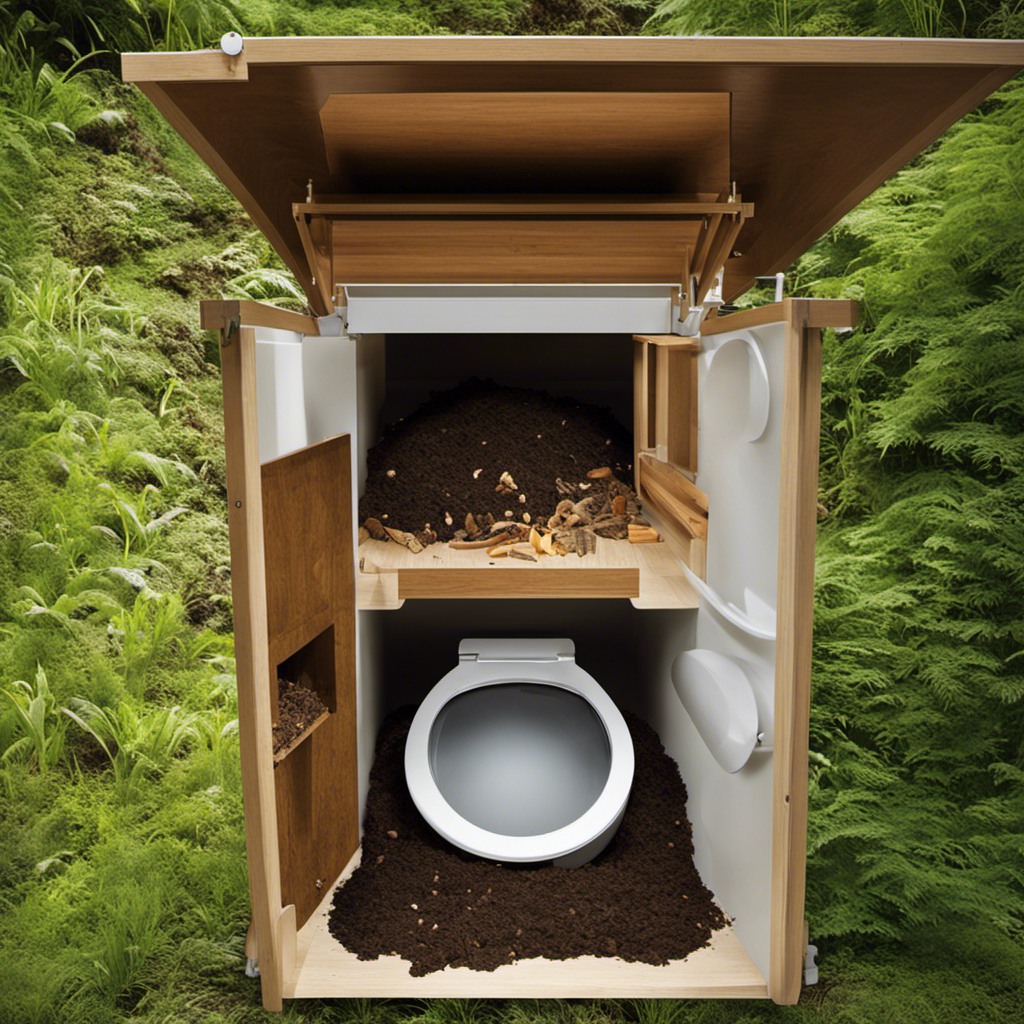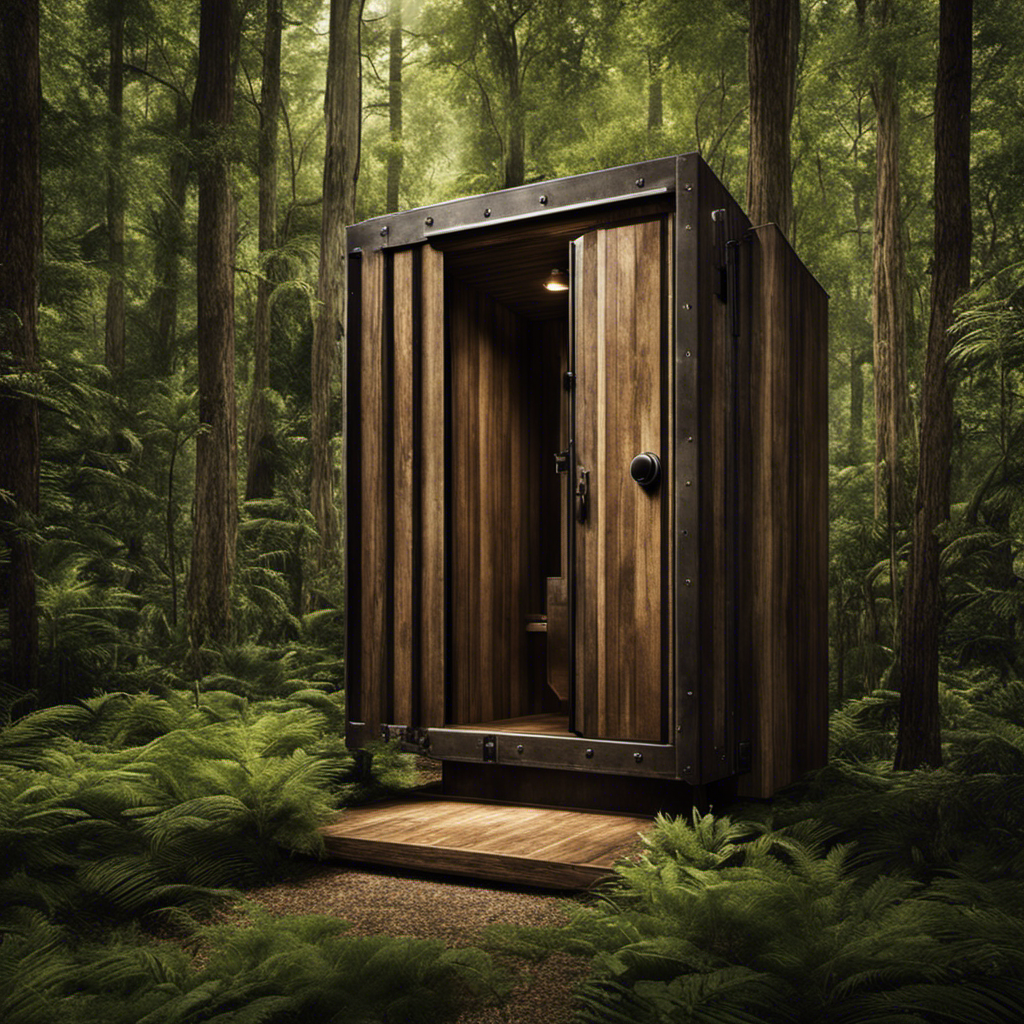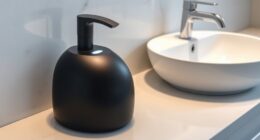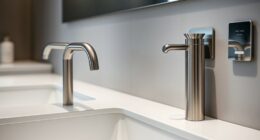Understanding the differences between squat and Western toilets shows how culture, plumbing, and health perceptions influence sanitation habits. Squat toilets, common in many Asian countries, emphasize traditional practices and natural positioning, which may improve bowel health. Western toilets prioritize comfort and convenience, especially for the elderly. Your choice often depends on local customs and infrastructure. Exploring these differences can reveal surprising insights into global hygiene practices—keep exploring to learn more about these fascinating variations.
Key Takeaways
- Cultural beliefs influence the prevalence of squat toilets in Asia and Western toilets in North America and Europe.
- Squat toilets promote natural posture, potentially improving bowel health and reducing straining.
- Western toilets prioritize comfort and hygiene, using seats and toilet paper, suited for elderly and mobility-impaired users.
- Plumbing infrastructure is designed to support each toilet type, impacting sanitation maintenance and regional adoption.
- Hygiene practices differ: squat toilets often use water for cleaning, while Western toilets rely on toilet paper and standard sanitation routines.
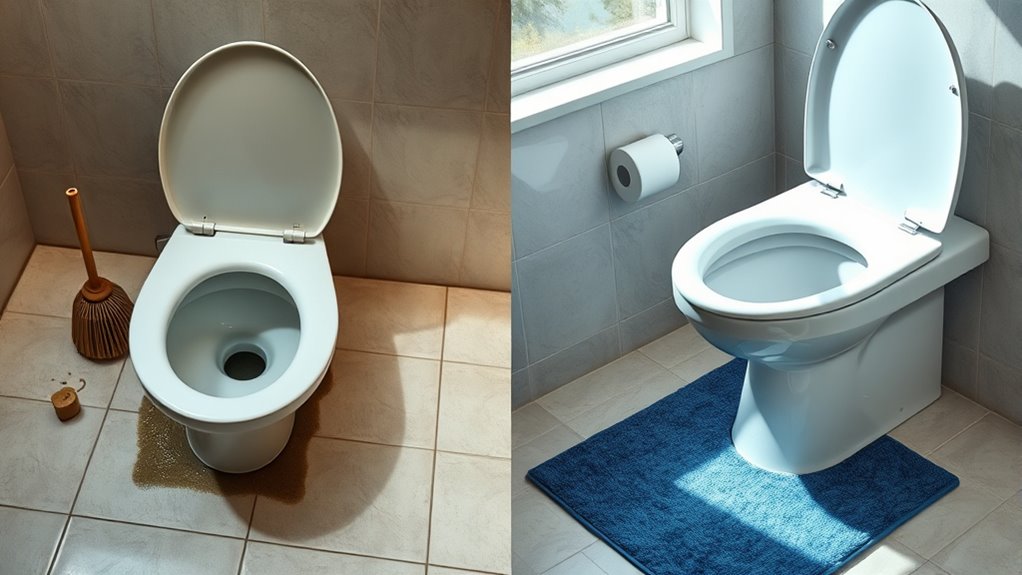
Toilet types vary widely around the world, reflecting deep-rooted cultural practices and beliefs about hygiene. When you consider different toilet styles, it’s clear that plumbing systems and sanitation practices shape what’s common and acceptable in a given region. For example, squat toilets are prevalent in many Asian countries because they align with traditional sanitation habits, while Western toilets are the norm in North America and Europe, influenced by different plumbing infrastructure and health standards. These differences aren’t just about convenience—they’re deeply tied to cultural perceptions of cleanliness and health.
Toilet styles reflect cultural practices, infrastructure, and perceptions of cleanliness worldwide.
If you’re visiting a country with squat toilets, you might notice that the plumbing systems are designed to accommodate them, often requiring specific drainage setups and flush mechanisms. These toilets are typically installed at floor level, forcing you to squat rather than sit. Many believe that this position offers better evacuation of waste, and in many cases, it’s considered more hygienic because your skin doesn’t touch the toilet seat. However, this style demands a different set of sanitation practices—using a water jet or a scoop to clean yourself afterward, and sometimes, specific footwear or mats to keep things sanitary. It’s a different approach to hygiene that’s embedded in local customs and infrastructure.
Western toilets, on the other hand, are designed for sitting and are integrated into plumbing systems that include water tanks or direct flush mechanisms. Their design emphasizes comfort and ease of use, especially for the elderly or those with mobility issues. In regions where Western toilets are common, sanitation practices often involve toilet paper and standard cleaning routines, which are supported by the plumbing systems that handle waste efficiently. The focus here is on convenience, with plumbing systems built to handle large amounts of paper and waste, reducing the risk of clogs and maintaining hygiene standards.
Your experience with either type also influences your perception of health and hygiene. Squat toilets are often praised for their natural position, which some studies suggest reduces straining and promotes better bowel movements. Conversely, Western toilets prioritize comfort, which can encourage more consistent use and better hygiene if maintained properly. Additionally, the suitable plumbing systems for each type play a crucial role in sanitation and maintenance. Ultimately, understanding these differences helps you appreciate how cultural practices and infrastructure shape sanitation habits worldwide. Whether you prefer the squat or Western style, recognizing the connection between plumbing systems and sanitation practices reveals how deeply rooted these choices are in tradition, health, and hygiene.
Frequently Asked Questions
Are Squat Toilets More Environmentally Friendly Than Western Toilets?
You might find squat toilets more environmentally friendly because they often use less water, supporting water conservation. Additionally, they tend to be made from sustainable materials, reducing environmental impact. By choosing a squat toilet, you contribute to conserving resources and promoting material sustainability. Overall, these features make squat toilets a more eco-conscious option compared to western toilets, helping you lessen your environmental footprint.
How Do Squat Toilets Impact Elderly Users Differently?
You might find that squat toilets pose challenges for elderly users due to mobility and balance safety concerns. They often struggle with the squat position, increasing fall risks and discomfort. If you or someone you care for has limited mobility, adapting to these toilets can be difficult, making Western toilets a safer choice. Prioritizing stability and ease of use helps protect elderly users from injury and discomfort.
Are There Specific Health Conditions Affected by Toilet Type Choice?
You might notice that your choice of toilet impacts your urinary health and digestive function. For example, squat toilets can promote better alignment, helping reduce issues like constipation and urinary tract infections. Conversely, Western toilets may be more comfortable but could lead to strain or incomplete evacuation for some. Your health conditions, like hemorrhoids or mobility issues, also influence which toilet type benefits you most.
Can Users Easily Adapt Between Different Toilet Styles Internationally?
You might find adapting between different toilet styles challenging due to adaptability challenges, especially if you’re used to one type. Cultural acceptance varies worldwide, making some toilets more familiar in certain regions. With a bit of patience and openness, you can adjust more easily. Familiarizing yourself with each style’s design and function helps overcome discomfort and makes switching between squat and Western toilets more manageable during international travels.
What Are the Cost Differences in Installing Squat Vs Western Toilets?
When comparing installation costs, squat toilets are generally cheaper upfront because they require less plumbing work and simpler fixtures. Western toilets tend to be more expensive to install due to their more complex design and additional plumbing needs. Maintenance expenses also differ; squat toilets usually have lower ongoing costs since they have fewer moving parts. Overall, your choice impacts both initial installation expenses and long-term maintenance costs.
Conclusion
Choosing between squat and western toilets is like picking between different musical instruments—you might prefer the traditional drum or the modern guitar, but both serve their purpose. Ultimately, it’s about what feels right for you, shaped by culture and health. Embrace the diversity, and remember, whether you’re dancing in the rhythm of a squat or strumming a western style, it’s your comfort that hits the right note. Find what suits you best and enjoy the harmony.




